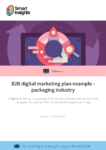How to apply our RACE Planning Framework and SOSTAC® to a B2B digital marketing plan
We pride ourselves in giving you content that you can apply directly to your company – whether you’re a burgeoning start-up trying to make your mark in a competitive market or an industry-leader taking your next step to global expansion. Our digital marketing plans are used by members from around the world in a wide variety of industries, which is why we’ve created a new batch of example marketing plans. These example plans will show you how our RACE planning framework can apply to specific industries and help you to set attainable targets for your marketing activities.
They combine two recognized methods of structuring digital marketing plans used throughout the Digital Strategy Toolkit – Smart Insights’ RACE Digital Marketing Planning™ and PR Smith’s SOSTAC®.
Our first digital marketing plan example is for the B2B packaging industry!
Download our Premium Resource – B2B digital marketing plan example – packaging industry
An example digital marketing plan that you can use to understand how a B2B company may use the SOSTAC® and RACE framework for long-term planning.
Access the B2B digital marketing plan example – packaging industry
So how do you create a B2B marketing plan?
1. Situational Analysis
Firstly, any plan needs to start with a summary of your digital strategy. This makes it easy for managers and stakeholders to understand the short and long-term goals you are going to achieve with reading the full plan. Split these up into a matrix of RACE and against strategies, tactics, and KPIs, like in the example below.
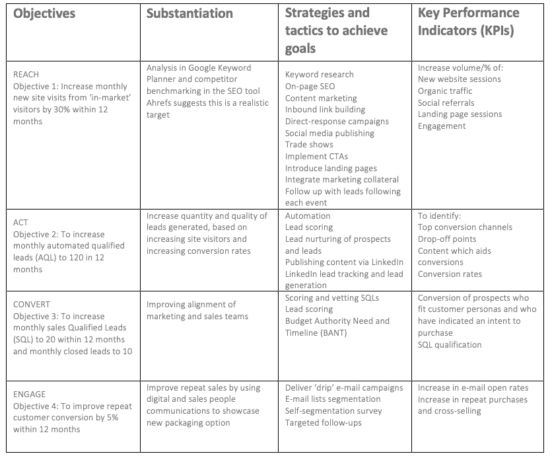
Within your situation analysis, you also need to include internal and external analysis to fully understand the wider market you're operating in, your current market share and your current marketing channels and tactics to understand if you're harnessing their full potential - all summed up in a SWOT/TOWS matrix. Remember to include in your situation analysis:
- PESTLE analysis - understanding the current political, economical, social, technological, legal and environmental climate and obstacles allows you to forward plan for any barriers that may come your way and control the situation without it affecting your market share or upcoming campaigns.
- Competitor research - know who your competitors are! Split these into direct competitors, secondary competitors, and indirect competitors.
- Market sector summary - review your findings by summarizing the external marketplace and competitors by calculating how much market share you own compared to others.
- Product range and marketing mix analysis - this is reviewing your 7ps (product, pricing, place, physical evidence, people and processes).
- Current performance - split performance into awareness, interaction/leads, sales/profit, loyalty/advocacy against VQV (volume, quality, value).
- Target audience personas - make sure you know who your target audience is. this will help later when creating a targeting and segmentation strategy. If you need help creating your personas, you can use our customer persona guide to review best practice examples.
- SWOT analysis - sum up your analysis detailing your current strengths and weaknesses and the opportunities these present.
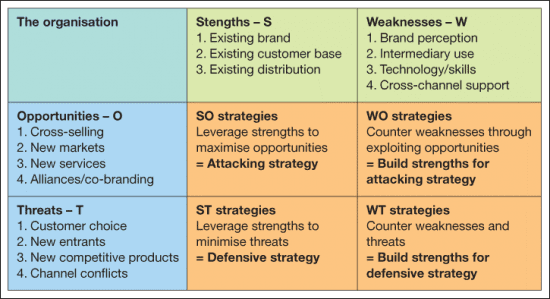
2. Objectives
Now that you've reviews internal processes and the external market, what are your next steps? What do you wish to achieve in the next 90 days, 6 months or 12 months? Make your objectives SMART and help improve the key issues you've found in your research.
If you've found that your reach is dropping and not as many customers are coming to your site then what objective have yous et in place to improve this?
- Key issues -Missed opportunities from SEO and social media, particularly LinkedIn. language barriers, cultural understanding, and motivations limited in some countries. Events and trade shows limited. No use of gated content. Time zone differences.
- Strategies to manage these issues - Social media amplification and advertising. Extend events programme. Implement forms on website alongside content. E-mail campaigns grouped according to time zone.
- Objectives - e.g. Increase website visitors by 23% within 6 months.
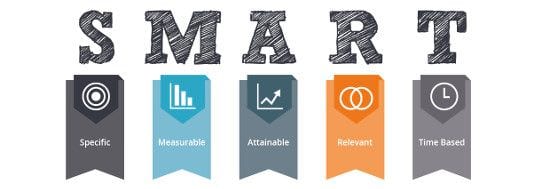
3. Strategy
What is your segmentation and targeting strategy? Without firstly knowing your personas in your situation analysis it will help understand how you plan to segment them to target them with relevant content at the right time. There are different targeting approaches you can take:
- Geography-based segmentation
- SEO and keyword research
- Paid search engine marketing
- Content marketing
- SN interest based targeting
- Channel preference
- Buying motivations and behaviours
4. Tactics
So you've created your objectives based on your situation analysis, you've chosen your targeting strategy and segmented your database, now how do you actually reach those new prospects?
Many tactics can contribute to one objective to reach your goals. Think about all the tactics you can do to reach more prospects:
- Keyword research and on-page SEO
- Inbound link building
- Content marketing on and off-site
- Direct response campaigns
- Social media publishing and promotion
- Trade shows presence
- CTA from websites
- Landing pages
5. Actions
What needs to be done to achieve your tactics?
Firstly, if you're focusing on content marketing you'll need to create your "hero content'.
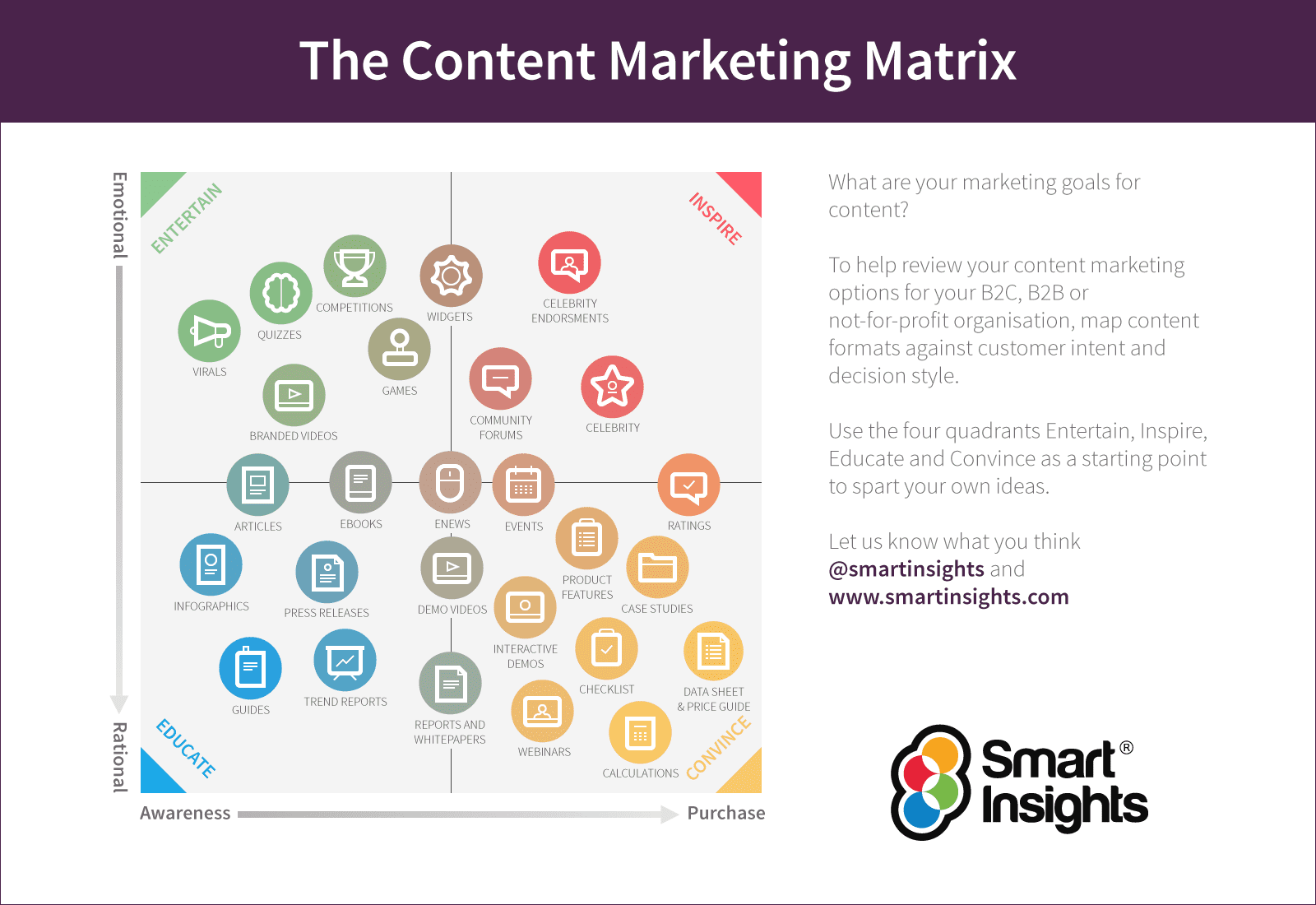
If your goal is to reach more prospects you will need to think about content that will both entertain/interest your audience and educate them about your company and product. Think about whitepapers, free guides, infographics etc. something that is easily shareable online to increase reach further.
If you're focusing on inbound link building, you'll first need to formulate a list. Or, if you're focusing on SEO, try and identify high-intention keywords. Think about the smaller actions that need to be done to achieve your wider tactic.
Have you thought about your B2B lead magnet?
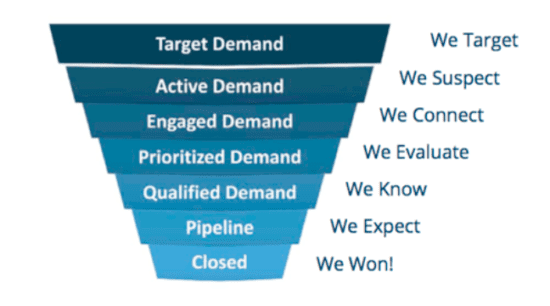
6. Control and continuous improvement
How will you measure results and keep score of improvements?
- Sales figures from accounting systems
- Data from Google Analytics
You may find our RACE digital marketing dashboard useful when reporting on top features month-on-month or year-on-year.
What testing is in place in case you don't see the results you need?



